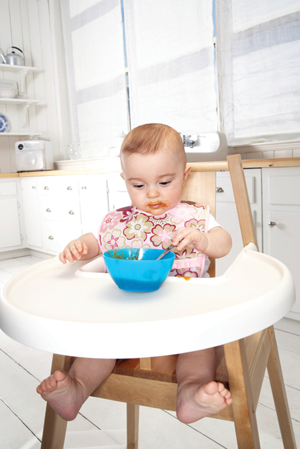Navigating a world beyond liquids with a newbie can seem like a daunting task for first-time parents. Questions abound: How do I gauge if the time is right for solids? Which foods do we try first? How much should my baby be eating a day? But introducing new tastes and textures doesn’t have to be complicated or stressful—the move toward meals your tyke can chew is a slow and steady process —and it can actually be a whole lot of fun. Below you’ll find answers to some of the most common queries about launching into lunchtime (and breakfast time, and dinnertime, and snack time …) with your little one.
Image may be NSFW.
Clik here to view. How do I know my baby is ready for more than a breast milk or formula diet?
How do I know my baby is ready for more than a breast milk or formula diet?
Watch your baby’s cues and trust your instincts. Does your baby show an interest in your food? Does she watch you and observe you as you eat? “A lot of children will literally reach out to the spoon as their parent is eating,” says Wendy Sue Swanson, MD, MBE, FAAP, author of Seattle Children’s Hospital’s Seattle Mama Doc blog. “That’s a definite sign of early readiness to begin solids.” Other milestones that indicate your child is progressing toward eating food include doubled birth weight, making cooing and laughing sounds, maintaining good head control, rolling, and sitting up assisted. Typically, these indicators happen between 4 and 6 months, but every baby is different. You know your baby best, so talk to your pediatrician about the right time for your baby to begin solids. “The bottom line: There’s no urgency and there’s no rush,” reassures Swanson. Respect your baby’s response and don’t ever push foods through pursed lips, but keep offering when you think she’s ready. Eventually she’ll open up eagerly for the next bite.
Which foods should I introduce my baby to first?
Though reconstituted rice cereal has long been suggested as an ideal first food due to its high iron content and easy-to-modify consistency, recent research suggests a reassessment is in order. “There have been new reports in the last year about arsenic contamination in rice, and so it’s recommended that babies have rice cereal only once a week,” reports Swanson. Beyond that, the food selection you make for baby’s first eats is entirely up to you. “There is no research showing that there is one perfect first food,” says Swanson. “You can choose peas, you can choose apricots, you can choose pears, you can choose apples, you can even choose puréed beef! What matters most is that you are allowing your baby to experiment with the feeling of food in her mouth.”
How much should my baby be eating?
Again, let baby be your guide. Your job as a parent is to make sure you’re offering a variety of foods for baby to try, and your baby’s job is to eat until she’s full and then know she can stop. “I’m a big believer in baby-led eating,” says Swanson. “Just like ours, babies’ appetites change from day to day. It’s really OK to follow their lead.” Some days your baby may eat a full jar of carrots, the next day she may eat one bite. The ability to accurately discern when your body is finished eating is an important skill to learn, and by letting your baby accept food at her own pace, without pushing or demanding it of her, you’re helping to teach that skill.
Should I delay introducing certain foods because of allergy concerns?
There have been questions in the past about when to institute “high-allergy” foods such as peanuts, eggs and shellfish into baby’s diet. The consensus was that waiting until a child was older before giving her foods from these categories would lower her risk of developing food allergies. However, Swanson says that thinking has been disproven. “What we’ve learned is that between the years 1997 and 2007, the rate of food allergies has increased almost 20 percent, and more quickly in developed nations that have likely been given the advice to delay high allergy foods. Now we’re saying that waiting on these foods may actually be more harmful.” Instead, Swanson encourages giving all foods on a regular timeline and watching your child’s response. But don’t jump right to serving omelets or spoonfuls of peanut butter at 4 months. “We don’t want these high allergy foods to be last, but we don’t want them to be first either.” Sprinkle in foods considered “at-risk” as allergens at varying intervals along the way. Both the American Academy of Pediatrics and the American Academy of Allergy, Asthma and Immunology recommend waiting three to five days between the introduction of new foods, in order to accurately gauge your child’s reaction to each specific food.
